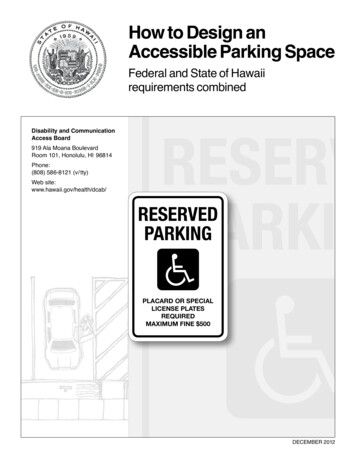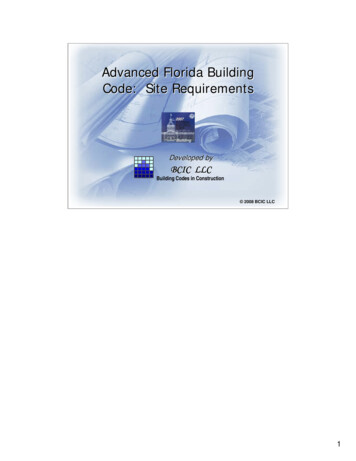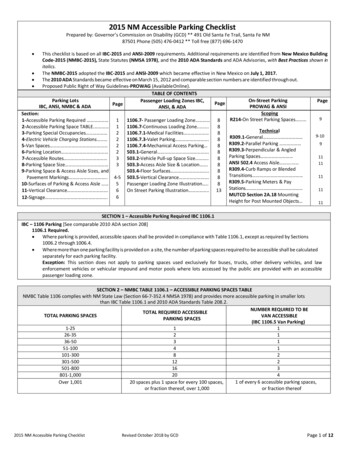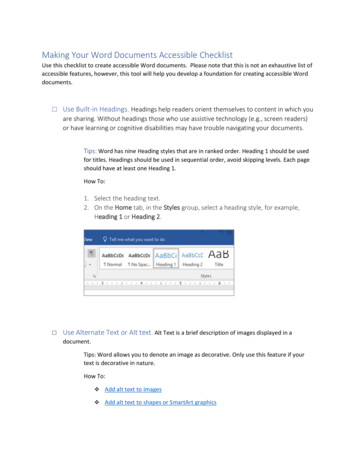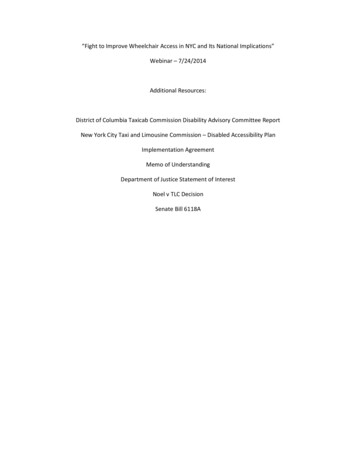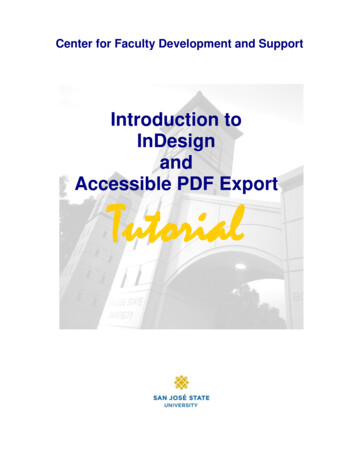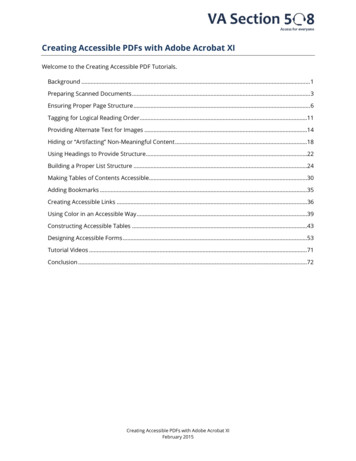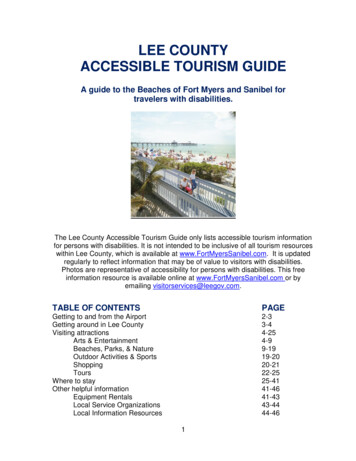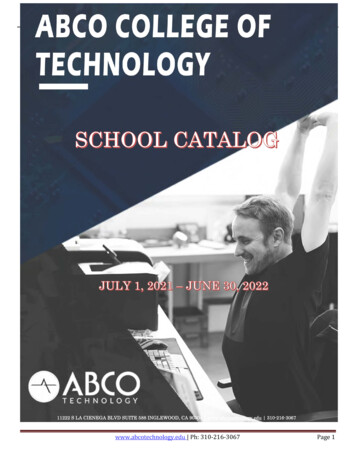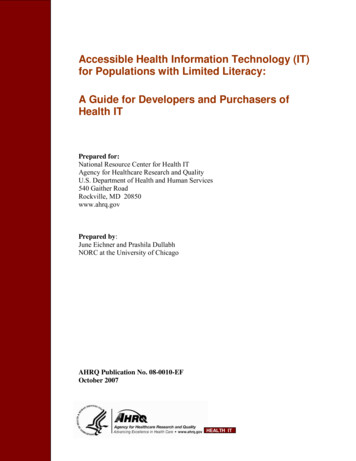
Transcription
Accessible Health Information Technology (IT)for Populations with Limited Literacy:A Guide for Developers and Purchasers ofHealth ITPrepared for:National Resource Center for Health ITAgency for Healthcare Research and QualityU.S. Department of Health and Human Services540 Gaither RoadRockville, MD 20850www.ahrq.govPrepared by:June Eichner and Prashila DullabhNORC at the University of ChicagoAHRQ Publication No. 08-0010-EFOctober 2007HEALTH IT
Suggested Citation:Eichner J, Dullabh P. Accessible Health Information Technology (Health IT) for PopulationsWith Limited Literacy: A Guide for Developers and Purchasers of Health IT. (Prepared by theNational Opinion Research Center for the National Resource Center for Health IT). AHRQPublication No. 08-0010-EF. Rockville, MD: Agency for Healthcare Research and Quality.October 2007.The authors of this report are responsible for its content. Statements in the report should notbe construed as endorsement by the Agency for Healthcare Research and Quality or the U.S.Department of Health and Human Services.ii
PrefaceThis guide and checklist are intended for developers and purchasers of health information (IT)that is designed to be accessed and used by consumers. As most health IT developers have littleknowledge of populations with limited literacy and of the technical standards and aspects ofaccessible health IT design, this guide and checklist provide a structure, strategies, and otherresources for the development of these technologies. Similarly, purchasers of health IT (e.g.,heath plans, pharmaceutical companies, foundations, and other non-profit organizations) thatdesire to make technologies available to limited-literacy adults, can use this guide and checklistto evaluate a health IT product. For those purchasers who contract out the development of theirproduct, this guide can be used to direct and validate the developer’s work.Our process for developing this guide and checklist included a review of the IT and health ITliterature; examination of products’ and organizations’ Web sites; and discussions withdevelopers and purchasers of health IT as well as researchers involved in the evaluation of healthIT for limited-literacy populations. Although we sought out well-documented, evidence-basedguidelines, we found that the development of accessibility standards for many of thesetechnologies is still in the early stages and that additional and larger scale research is needed.Thus, we have compiled a checklist based on what is known at this point in time and hope thatthis checklist will be updated as additional evidence becomes availableThe term “health IT” is used throughout this guide to refer to hardware and software as well as devices, applications, andinterfaces.iii
ContentsSection I. Introduction to this Guide and Checklist .1Section II. Overview of Health IT for Limited-Literacy Populations .3Section III. Principles of Accessible and Usable Health IT.4Universal Design .4Guidelines for all Health Information Technologies .4Plain and Clear Language Is Used .5Content Is Relevant to Audience .6Format Is Conducive to Reading and Comprehension .6Content Appeals to Diverse Racial and Ethnic Groups .6Application Has Undergone Iterative Testing and Revision .7Guidelines for Specific Health IT .9Internet Web sites .9Computer Kiosks .9Mobile Phone, BlackBerry, and Personal Digital Assistant (PDA).10Home- or Self-Care Medical Devices .10Section IV. Additional Resources .12AppendixAccessible Health Information Technology (IT) for Limited-Literacy Populations Checklistiv
Section I. Introduction to this Guide and ChecklistHealth information technology (IT) has become an important vehicle for providing healthinformation to consumers and is increasingly being used by consumers for other functions,including self-care, informed and shared decisionmaking, connecting with health care providers,communicating with others with similar health issues, and storing and accessing personal healthrecords. Of concern, however, is that the literacy level required to effectively use most health ITis much higher than that of a large share of the U.S. population, and its content and format poseconsiderable barriers as well.1 To ensure that those with limited literacy benefit from thesetechnologies, health IT must be designed to be accessible to these populations.Numerous reasons may explain why so little attention has been paid to making health ITavailable to limited-literacy populations. These reasons include the perception that limitedliteracy populations lack access to health IT and would not know how to use these devices andapplications; that the number of adults with limited literacy is small and insignificant; and thatthere are few financial incentives to encourage the development or purchase of such IT. Oftenoverlooked, however, are the benefits to developers and purchasers for their design of accessiblehealth IT for limited-literacy populations. These benefits include: Broadening the potential audience. A large percentage of adults have limited literacy: 14percent (30 million) have below basic prose literacy, and 29 percent (62 million) have basicprose literacy.2 These 92 million persons provide considerable opportunity to expand theaudience of health IT products.Increased understanding and usage for all populations, including those with higher literacy.Higher literacy user groups also benefit from making health IT accessible to limited-literacypopulations.Enhanced reputation. Developers and purchasers demonstrate expertise in reachingvulnerable populations and their social responsibility towards adults with limited literacy. Fordevelopers, this reputation can translate into increased business from purchasers.With the health care environment’s increasing emphasis on engaging consumers in their care, themarket for consumer health IT has been expanding. To support this new paradigm, health plansare providing consumers with information and tools to enhance their decisionmaking ability.Similarly, State and Federal Governments are promoting the development of health IT, includinga focus on personal health records and other systems that interface with consumers. As healthThere are multiple dimensions of literacy. General literacy is defined as the ability to utilize reading, writing and computationalskills to function in society. Health literacy is the ability to obtain, process, understand, and act on health information. eHealthliteracy is the ability to seek, find, understand, and appraise health information from electronic sources and apply this knowledgeto addressing or solving a health problem.2Below basic prose literacy is defined as literacy to complete no more than the most simple and concrete literacy skills; basicprose literacy is defined as literacy to perform simple and everyday literacy activities. U.S. Department of Education, Institute ofEducation Sciences, National Center for Education Statistics, 2003 National Assessment of Adult Literacy.http://nces.ed.gov/naal/kf demographics.asp. Accessed September 24, 2007.11
plans and governments strive to engage consumers in their own care, accessible information andtools to support and empower consumers—including those with limited-literacy—will be crucial.When properly designed, health IT is used by limited-literacy populations. The table belowhighlights three health IT products that have been well-received and utilized by adults withlimited literacy.Examples of health IT that have been well-utilized by both limited- and higher literacypopulationsMiVIAAn Internet-accessible personal health record (PHR) in Spanish for migrant andseasonal farm workers, MiVIA’s goal is to improve users’ health outcomes,continuity of care, and health literacy. MiVIA also allows for access to email and amember portal that provides community resource information in accessiblelanguage and format. It also includes a provider portal that allows providersaccess to workers’ health information. MiVIA is now used by 5,200 farm workers.Health HeroA “technology in a box” home health device that plugs into a phone line, HealthHero prompts the user with easy-to-read health questions, collects data, thentransmits the data to a provider. It is the predominant home health device used bythe Veteran’s Administration (VA), with over 80 percent of patients in the VA’shome health program utilizing it.CHESS(ComprehensiveHealthEnhancementSupport System)breast cancermoduleAn information and support Web site for women with breast cancer, CHESSprovides information services (a compilation of frequently asked questions andanswers, articles on breast cancer, a resource guide and directory of organizationsand services), support services (discussion groups, ask an expert, and personalstories), and decision services (assessment tools, health charts, and decisionaids).It is hoped that this guide will facilitate the development of health IT accessible to limitedliteracy populations and that it will be used by purchasers of health IT as a product evaluationguide. The rest of this guide is organized as follows: Section II is an overview of health IT for limited-literacy populations.Section III describes the principles of accessible health IT.Section IV is a list of additional resources.The checklist for the design and purchase of accessible health IT is included as an Appendix.2
Section II. Overview of Health IT for Limited-LiteracyPopulationsHealth IT offers limited-literacy (as well as higher literacy) populations numerous advantages: Increased availability and access to health information. Information is provided on a widerange of topics, offering basic to in-depth information on each topic.Access and management of their own health care information (e.g., personal health records).Learning opportunities that are more visual and interactive than printed materials and othertraditional forms of health education. Users may enter information, receive personalizedfeedback, and have information transmitted to health care providers who then monitor andfollowup their care.Below is an overview of the predominant health IT for use by consumers, with examples of whatthey typically offer and how they are used.Predominant health IT for use by consumersInternet Web sitesAlong with making health information available onalmost any subject, Web sites offer interactivehealth tracking tools, message boards and chatrooms, and host interfaces such as Web portals,personal health records, and secure patientprovider messaging.Touchscreen kiosksCommonplace in shopping malls, grocery stores,and banks, kiosks provide educational sessionsaimed at improving self-care for a specific healthcondition.Personal wireless devices(cell phone, BlackBerrry, and PDA)Small, portable, and private, these devices havethe ability to send and receive text messages andemail, host games, and interface with the Internet.Home monitoring devicesFor use by patients and/or home care providers,these devices are tied to an information system andgive actionable information to patients and/orproviders.Health IT usage by those with limited literacy remains well below that of higher literacypopulations. Although the availability and use of computer and other health IT has increasedamong limited-literacy populations, a digital divide remains. Developers and purchasers ofhealth IT can help to reduce this divide by ensuring that the reading level, content, and format ofthese technologies are accessible to limited-literacy populations.3
Section III. Principles of Accessible and UsableHealth ITTo best serve users of health IT, information must be both accessible and usable. This guide usesthe term “accessibility” to refer to how well users can use a product to achieve their goals andhow satisfied they are with that process (some call this “usability.”) Many of the issues raised bythe term “accessibility” are addressed by the universal design approach. This section describesthe importance of universal design, overall guidelines for accessible health IT, and guidelines forspecific health IT (Internet Web sites; computer kiosks; mobile phones, BlackBerrys, andPersonal Digital Assistants; and home monitoring devices).Universal DesignUniversal design endorses the design of products, services, and environments so they are usableby as many people as possible, regardless of age, ability, or circumstance.3 It suggests that alltechnologies meant for use by the general public should also be accessible to limited-literacypopulations.Below are the basic universal design principles. Although most developers will be familiar withthis terminology, purchasers of health IT who are not should ask developers whether theseproperties are incorporated into their design.Basic universal design principles are: Design simply: Technologies and applications should be simple, emphasizing importantelements, simple structures, and clean, standards-based markup.Build well: Take full advantage of inherent health IT properties, such as fallbacks, flexibility,and user control. (See universalusability.com Web site for additional information.)For Internet sites, use HTML over other formats: Provide documents in nonstandard formats(e.g., PDF and Flash) only as an alternative to HTML.4Health IT incorporates many elements that support universal design, although attention isrequired to ensure that they are used to enhance usability for limited-literacy populations. IT(and non-IT) guidelines and evaluation tools often do not address literacy, and care must be paidto ensure that literacy is directly and sufficiently addressed.Guidelines for all Health ITA number of general guidelines are applicable to the different types of health IT. Many of theseguidelines are adapted from low-literacy guidelines for print materials (e.g., pamphlets).Although print guidelines have been around for many years, they retain their relevance and serveas the foundation for accessible health IT.34The Center for Universal Design. http://www.design.ncsu.edu/cud/about ud/about ud.htm. Accessed September 30, 2007.Universalusability. http://universalusability.com/access by design/index.html. Accessed September 17, 2007.4
The major principles for ensuring accessible health IT for those with limited literacy include theuse of the following: Plain and clear language.Content that is relevant to the audience.Format that is conducive to reading and comprehension.Content that appeals to diverse racial and ethnic groups.Content that has undergone iterative testing and revision.The following sections discuss the rationale for each of these principles, checklist items tocomply with these principles, and elaborate on those items that would benefit from examples orfurther explanation.Plain and Clear Language Is UsedAdults with limited-literacy comprehend best when plain and clear language is used. Plain andclear language presents information in a way that makes it as easy as possible for people tounderstand. The goal is that users will understand a document the first time they read it.Some attributes of plain and clear language are as follows: Words are short, simple, and familiar (1-2 syllable, no jargon, acronyms, abbreviations).Unavoidable medical and technical terms are explained.Sentences are short.Content is written in the “active” voice (rather than “passive” voice).Word usage is consistent throughout.Reading level is not above 6th grade.As per the last bullet, it is crucial that the reading level not be higher than the 6th grade. Studiesshow that the reading level for most IT materials is far beyond the reading level of limitedliteracy populations, and that most health education material is written at a 10th grade or higherlevel. Although it may be difficult to write or rewrite materials below the 6th grade level, overone-fifth of adults are unable to read above the fifth grade level.5 In addition, the reading leveldoes not provide a complete picture of whether a user will be able to comprehend and use adocument.A number of tools are available to assess reading level (e.g., Flesh-Kincaid and SMOG(Simplified Measure of Gobblegook)). Reading level is usually computed “by hand,” althoughsome of these tools are available as a computer application, such as those included in Microsoft Word. All documents that are to be tested should be “prepared” before the assessment. Thisentails removing periods from abbreviations, colons, and semi-colons, because if not removed,they are counted as the end of a "sentence" and will result in an underestimation of the gradelevel. (See Section IV, Additional Resources, for further information.)5Get Caught Reading. http://www.getcaughtreading.org/literacyfacts.htm. Accessed September 30, 2007.5
Content Is Relevant to AudienceAlong with being able to use and comprehend a health IT, its content must be relevant to prospectiveusers. Users must have a need and desire for the information, and it must assist them in meeting theirhealth care needs. The content must also be framed appropriately. For example, information pitched atthose who are already familiar with the subject matter or bombarding users with too much information atone time may cause users to exit the health IT application and not return. Such users may also bediscouraged from using other health IT applications.The following items are important for the development of content relevant to a limited-literacyaudience: Assumes little or no background knowledge (including understanding of the body and thehealth care system).Information is relevant to users.Limited number of messages are delivered.Numbers and percentages are appropriate (e.g., only one number provided per point, nocalculations or inferences are required, and use easy-to-understand phrasing, such as 1 in 10instead of 10 percent).Graphic illustrations clarify text.Format Is Conducive to Reading and ComprehensionThe format of the document influences a person’s ability to read and comprehend it. Adults withlimited-literacy may be particularly disadvantaged by a difficult-to-read format. The format ofhealth IT is especially important because many IT features, such as scrolling, moving objects,animation, and search functions, are difficult for adults with limited literacy.The following are key to an accessible format style: A lot of white space (fewer words or less dense text).Short line length, preferably a maximum of 40-50 characters.Similar information grouped into sub-sections or “chunked.”Bullets and Q&A used to break up text.Dark text (preferably black) on a light or white background.Large and familiar font (at least 12-point, Arial, Helvetica, Verdana, or Times New Roman).Consistent use of font sizes and styles throughout.Upper and lower case letters (do not use all capital words as they are more difficult to read).Justification of left-hand margin only.Content Appeals to Diverse Racial and Ethnic GroupsTo promote the use of health IT among racial and ethnic minority groups, immigrants, andEnglish-as-a-second-language speakers, it is important to pay attention to culture and language.Health IT can be made more appealing to a multicultural audience by drawing on examples fromdiverse ethnicities. All information about any racial or ethnic group should be accurate and notpromote stereotypes. (See Section IV for cultural competency information and resources.)6
To promote the use of health IT among racially, ethnically, culturally, and linguistically diverseusers, ensure that: Content is culturally appropriate and sensitive to users.Members of these groups are portrayed accurately in pictures and other graphic illustrations.Translation from English is accurate and idioms and expressions are appropriate.Target population is specified (if appropriate).Content Has Undergone Iterative Testing and RevisionFollowing recommended guidelines helps to increase the accessibility of limited-literacypopulations. It is just as important, however, that the health IT is tested repeatedly throughout thedesign process, and that prospective users are included in the testing. All versions in additionallanguages should be tested by native speakers.The conceptual design should be assessed throughout the design process. This may include areview of the sample prototype through discussions, brainstorming, or storyboarding (a series ofsimple pictures to show the sequence for completing a task) with prospective users. Afterrevision, the health IT should undergo an initial accessibility review by the design team and betested by prospective users. The testing by prospective users—also called a usability test—should address the following questions: Is the application easy to use and navigate?Is the content appropriate, acceptable, and applicable?Will participants want and choose to use the application?Again, the health IT should be revised based on the test results. Testing and revision shouldcontinue until there is little to be learned from additional testing.Healthfinder.gov is an example of a Web site that has employed an iterative design process toproduce a highly usable Web site. Developed by the U.S. Department of Health and HumanServices as a health promotion tool, this Web site began as a paper prototype and was tested andrevised over a 3-year period.As of August 2007, the healthfinder.gov home page and “Eat Healthy” section appeared asfollows:7
The process for iterative testing and revision is as follows: Draft and review sample prototype.Conduct a team review of accessibility, and one by health literacy experts, if feasible.Revise based on team and expert review.Test with target audience, including limited-literacy and culturally diverse persons Watch testers use it Ask testers about their experience Assess testers’ comprehensionRevise based on tests with target audience.Test in all languages, if appropriate8
Guidelines for Specific Health ITThe various types of health IT discussed in this guide (Internet Web sites; computer kiosks;mobile phones, BlackBerrys, and Personal Digital Assistants; and home monitoring devices)differ in their hardware and software and how they are utilized. Thus, in addition to the generalguidelines discussed, each of these forms of health IT has its own set of guidelines. Following isan overview of potential accessibility issues for each, guidelines to enhance accessibility, andother suggestions to support the development of health IT for adults with limited literacy.Internet Web sitesInternet Web sites pose considerable barriers to their use, particularly for adults with limitedliteracy. As the Web site usability consultant Jakob Nielsen stated: Difficulty reading andcomprehending Web site materials may be exacerbated for adults with limited literacy. Themost notable difference is that users with limited literacy cannot understand a text by glancing atit. They must read word for word because they cannot skim and decide what to skip, and manytimes are forced to skip over large amounts of information. When they have to scroll, it breakstheir concentration because they cannot scan to find where they left off. Also, searching createsproblems because they have difficulty spelling. For those who successfully spell their searchwords, the fragmentation of search results makes it difficult for them to choose those results mostrelevant to their needs.6Adherence to the following will help overcome many Internet Web sites’ obstacles (see thechecklist in Section IV for in-depth items): Designed for old hardware and softwareHome page is simpleInformation is prioritizedMinimal amount of text per screenNavigation is simple and consistentNeed for scrolling is minimizedSearching is simplifiedLinks (hyperlinks) are provided for additional information, with clearly defined hyperlinksthat link directly to the informationPrinter-friendly option is providedAudio transcription option is providedSite map is easy to findContact information is easy to findComputer KiosksThe term “computer kiosk” may refer to both a computer and its box, or it may refer to thecomputer itself, because an interactive computer may function as a kiosk without the box. Oftenthe term “kiosk” is meant to convey a computer that uses a touchscreen technology, rather thanthe box itself.6Jakob Nielsen’s Alertbox, Low-Literacy Users, http://www.useit.com/alertbox/20050314.html. Accessed September 6, 2007.9
Computer kiosks are often used in health care facilities as a means of educating patients to carefor a specific health condition. The usability of the computer kiosk depends on the person beingable to quickly learn to operate the computer and application, and a message that is conveyedsimply and succinctly. These applications are most effective when they use a “teach back”technique, which provides a multiple choice quiz that has the user restate the messages taught.Checklist items specific to computer kiosks are: Preliminary practice session provided.One question or idea presented per screen.Information limited to what is needed to manage the health problem.Option to repeat messages.Audio transcription, if appropriate.“Teach back” techniques used to reinforce and confirm learning.Mobile Phone, BlackBerry, and Personal Digital Assistant (PDA)As cell phones and PDAs take on Blackberry’s software and Internet capabilities, thesetechnologies have the ability to accommodate similar health IT. Health IT for these devices isavailable for recording and reinforcing health behaviors and managing chronic conditions.Reminder messages can be sent through voice mail, and simple, easy-to-read reminders can besent via text messaging. In addition, new and advanced devices are available that record andtransmit biomarkering data from individuals to health care providers. The opportunity to rely onvoice (rather than text) also offers the potential for increased accessibility for those with limitedliteracy. However, to be usable by limited-literacy populations, the device’s design andapplications must be readable, accessible, and its text messages simple.Handheld technologies are more accessible when: Design features are geared to adults with limited literacy (e.g., large keys, letters on all keys,simple navigational structure, increased size of device).Reliance on text is minimized (e.g., use of voice-to-text technology or text-to-voicetechnology).Text messaging is simple (e.g., uses short and familiar words, accommodates commonmisspellings).Home Monitoring DevicesThe increased emphasis of our health care system on home- and self-care has spurred thedevelopment of home monitoring technology for use by patients themselves or home healthproviders, many of whom have limited literacy. Advances in health IT now tie home monitoringdevices to an information system that provides actionable information to patients and providers.Proper usage and accessibility for adults with limited literacy will depend on the design of thedevice, its application and interface, and the quality of the instructions provided.10
Accessible home- or self-care medical devices should adhere to the following: Device designed for use by adults with limited literacy Appropriate for home, work, and other useDisplay of information readable and comprehensibleCompact (but still readable)Easy to operate, with limited number of stepsLow maintenanceLarge keys with clear iconsSelf-calculatingStores test resultsSingle function buttonsVoice instructions and resultsAutomatic calibrationClear and easy-to-follow instructions provided through simple print and video tutorials (online or DVD) and help manuals Content is readable and appropriate (as in general health IT guidelines)Instructions reiterate and review main stepsNumbered steps are used to describe proceduresSteps are described in the same order in which they will be performedEach step is illustratedCritical components or warnings are emphasizedPhone number for customer support is providedThe last section, Section IV, lists additional resources, including tools and additionalinformation, for the development of accessible health IT for populations with limited literacy.The complete checklist for accessible health IT for populations with limited literacy follows.11
Section IV. Additional ResourcesTranslation of medical terminology to clear and simple EnglishMedicalese-English ons/documentlibrary/2.2.6%20LindaAndrews com%20Medicalese%20Translator.htm.Usability background and guidanceJakob Nielsen's Usability Web Site: useit.com. See “Lower-Literacy ml.Usability.gov. Usability formatio
guide. The rest of this guide is organized as follows: Section II is an overview of health IT for limited-literacy populations. Section III describes the principles of accessible health IT. Section IV is a list of additional resources. The checklist for the design and purchase of accessible health IT is included as an Appendix.
